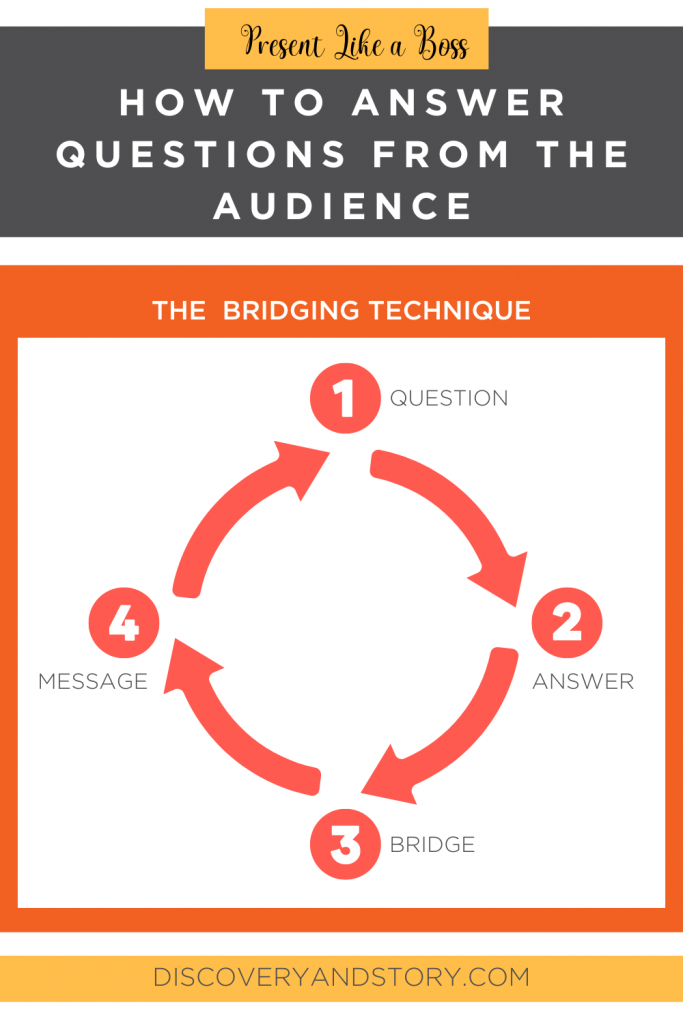
For some people, answering questions is the hardest part of speaking to a group. It could be the fear of being asked something we do not know, or that a strong personality will dominate the discussion. Or that we give up some control.
But, we can turn audience questions to our advantage. When we hear what the group is thinking, we can clear up confusion and can even work in additional information, examples or data points to help reinforce a particular topic. Answering questions at the end also provides an opportunity to reinforce key messages we want the audience to remember once we are done.
How the Bridging Technique Works
Bridging is a technique often taught as part of media training sessions, but we can apply it to any business situation where we need to respond to questions.
The process is:
- Someone asks a question, and we respond to it.
- We use a bridging phrase. (More on this below.)
- We share one of our key messages that we want the audience to remember.

For example, someone might present a status update on a project during a team meeting. Their manager may ask the question: We will likely need to reduce the budget for this project next year – what areas do you think we can reasonably cut?
The person could respond with something like:
- Answer the question: I know we will likely need to reduce the budget next year, and I am thinking through a few options depending on the amount we will have next year.
- Bridging phrase: What is most important to know is…
- Main message you want to share: This project is important to our growth as a company. As I shared today, we are already having a measurable impact. One area I think has the biggest potential is XXXX, so I want to make sure we continue to fund this next year.
As another example, a freelance graphic artist might pitch her services to a potential new client. The client may ask the question: How quickly can you turn projects around?
The graphic artist could respond with something like:
- Answer the question: My turnaround time will vary depending on the project specifics but I can generally able to turn smaller projects around in X to X days and I can usually turn around edits to the initial drafts in X days.
- Bridging phrase: Having said that…
- Main message you want to share: One of the most important things to me, as I said earlier, is producing the highest quality product I can. So, I do appreciate a few extra days if possible to make sure I’m bringing you the most creative solutions and ideas I can. I would work with you on what is reasonable for the individual project.
The reason bridging can be so powerful is because it allows us to answer the question asked while also reinforcing the ideas we want to share. In this way, we have a greater chance that people will remember our main points after the presentation or meeting is done.
A Few Examples of Bridging Phrases
A bridging phrase is simply a way to transition from answering the question to making the point you want to add. Below are a few examples and there are hundreds of others.
- I’d also like to add that…
- Just to put this into context…
- To put this in perspective…
- Before we leave this topic, let me add…
- Here’s the real problem…
- Let me also share again…
- As I said before…
- It all boils down the this…
- What is most important to know is…
- It’s also important to remember…
Not all of these will resonate with you. The important thing is to pick one or two of these and practice them. If they do not feel authentic to you, swap it out with another one and try again. Eventually, you will settle on a couple that will become your go-to bridging phrases whenever you want to use this technique.
How to Respond to a Question When You Do Not Have the Answer
There will be times when someone asks a question we do not have the answer to right away. In those cases, you could say something like: Great question. I do not have the answer to that one right now, but it’s an interesting point and I’ll follow up on it. Then move on to the next question. Depending on the situation, you can follow up with the person or group later with the response.
Take Action
Ready to try this technique in your next meeting or presentation at work? To start, pick one or two bridging phrases from the list above and try them out. It takes practice to become comfortable responding to audience questions and using techniques like bridging. Over time, it will become easier and you will find what works best for you.

